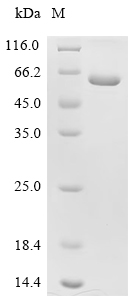Recombinant Human Taste receptor type 1 member 2 (TAS1R2) is produced in E. coli with a C-terminal 6xHis-tag, covering amino acids 20 to 566 of the protein. This partial recombinant protein maintains a purity level greater than 95%, as confirmed through SDS-PAGE analysis. It's designed strictly for research use, which should help deliver reliable results in scientific studies.
TAS1R2 appears to be a key component of the taste receptor complex that detects sweet and umami flavors. The protein likely plays a significant role in how we perceive taste by forming heterodimers with other taste receptor proteins. Understanding this receptor may be essential for unraveling taste mechanisms. Its research applications extend into nutritional studies, particularly when examining how taste preferences might influence dietary choices and metabolic health.
Potential Applications
Note: The applications listed below are based on what we know about this protein's biological functions, published research, and experience from experts in the field. However, we haven't fully tested all of these applications ourselves yet. We'd recommend running some preliminary tests first to make sure they work for your specific research goals.
Based on the provided information, the recombinant human TAS1R2 is expressed in E. coli, a prokaryotic system that is fundamentally unsuitable for producing functional eukaryotic G-protein coupled receptors (GPCRs) like TAS1R2. Taste receptors are complex transmembrane proteins that require precise folding, proper membrane insertion, glycosylation modifications, and heterodimerization with TAS1R3 for their sweet taste recognition function. The protein is expressed as a partial fragment (20-566aa) with a C-terminal 6xHis tag and >95% purity. However, E. coli lacks the eukaryotic chaperones, membrane environment, and post-translational modification machinery necessary for the correct folding of this complex GPCR. The partial nature of the expression (missing the N-terminal 19 amino acids) and the C-terminal tag may further interfere with proper structure formation. Since activity is explicitly unverified, the protein cannot be assumed to be correctly folded or bioactive without experimental validation of its ligand-binding capability and proper membrane protein conformation.
1. Protein-Protein Interaction Studies Using His-Tag Pull-Down Assays
The C-terminal 6xHis tag enables technical feasibility for pull-down assays. However, if TAS1R2 is misfolded (as highly likely in E. coli for this GPCR), it will not interact physiologically with true binding partners (e.g., TAS1R3, G-proteins). GPCRs require a precise seven-transmembrane architecture for specific interactions. Identified interactions could be non-physiological artifacts. This application should not be pursued without confirmation of proper folding and membrane integration.
2. Antibody Development and Validation
The recombinant TAS1R2 fragment can serve as an effective immunogen for generating antibodies that recognize linear epitopes, even if the protein is misfolded. The partial sequence (20-566aa) provides a substantial antigenic surface. However, antibodies may not recognize conformational or glycosylation-dependent epitopes of native, properly folded TAS1R2 in taste receptor cells. Validation against endogenous TAS1R2 from mammalian tissues is essential.
3. Biochemical Characterization and Stability Studies
This application is well-suited for assessing the recombinant human TAS1R2 itself. Techniques like circular dichroism spectroscopy, size-exclusion chromatography, and thermal shift assays can evaluate the protein's folding state and stability. These studies are valuable even if the protein is inactive, as they characterize the recombinant product and can inform about its suitability for other applications.
4. In Vitro Binding Assays with Small Molecules
This application is highly problematic without proper folding validation. If TAS1R2 is misfolded and not properly inserted into a membrane environment, binding assays will not reflect biological specificity. Taste receptors require correct seven-transmembrane architecture and dimerization for specific ligand recognition. This application requires prior demonstration of proper folding in a membrane-like environment and validation with known sweet tastants.
Final Recommendation & Action Plan
Given the extreme challenges of producing functional GPCRs in E. coli, recommend first performing comprehensive validation: 1) Biophysical characterization (circular dichroism for secondary structure, analytical ultracentrifugation for oligomeric state) to assess folding quality; 2) Functional validation in a membrane reconstitution system if possible; 3) Comparison with TAS1R2 expressed in eukaryotic systems. Antibody development can proceed immediately as the safest application. Completely avoid all functional studies (interactions, binding assays) until proper folding and membrane integration are confirmed. For reliable TAS1R2 research, obtain the protein from mammalian or insect cell expression systems capable of proper membrane protein folding and post-translational modifications. Always include appropriate controls, such as known ligands and validated receptor preparations, in experiments.






